Deakin University MBA710a Business Process Management Report
VerifiedAdded on 2023/06/09
|20
|4359
|459
Report
AI Summary
This report provides a comprehensive analysis of business process management (BPM) within an organization, focusing on aligning business processes with strategic goals. It identifies problems such as declining business growth, communication breakdowns, procurement inefficiencies, sales target failures, and outdated accounting software. The report uses tools like process diagrams and gap models to illustrate the current state (As-Is) and the desired future state (To-Be). Proposed solutions include redesigning business processes, implementing a BPM support group, and adopting a hybrid model for process improvement. Recommendations are provided to enhance organizational performance and address the identified issues. Desklib provides students access to similar solved assignments.
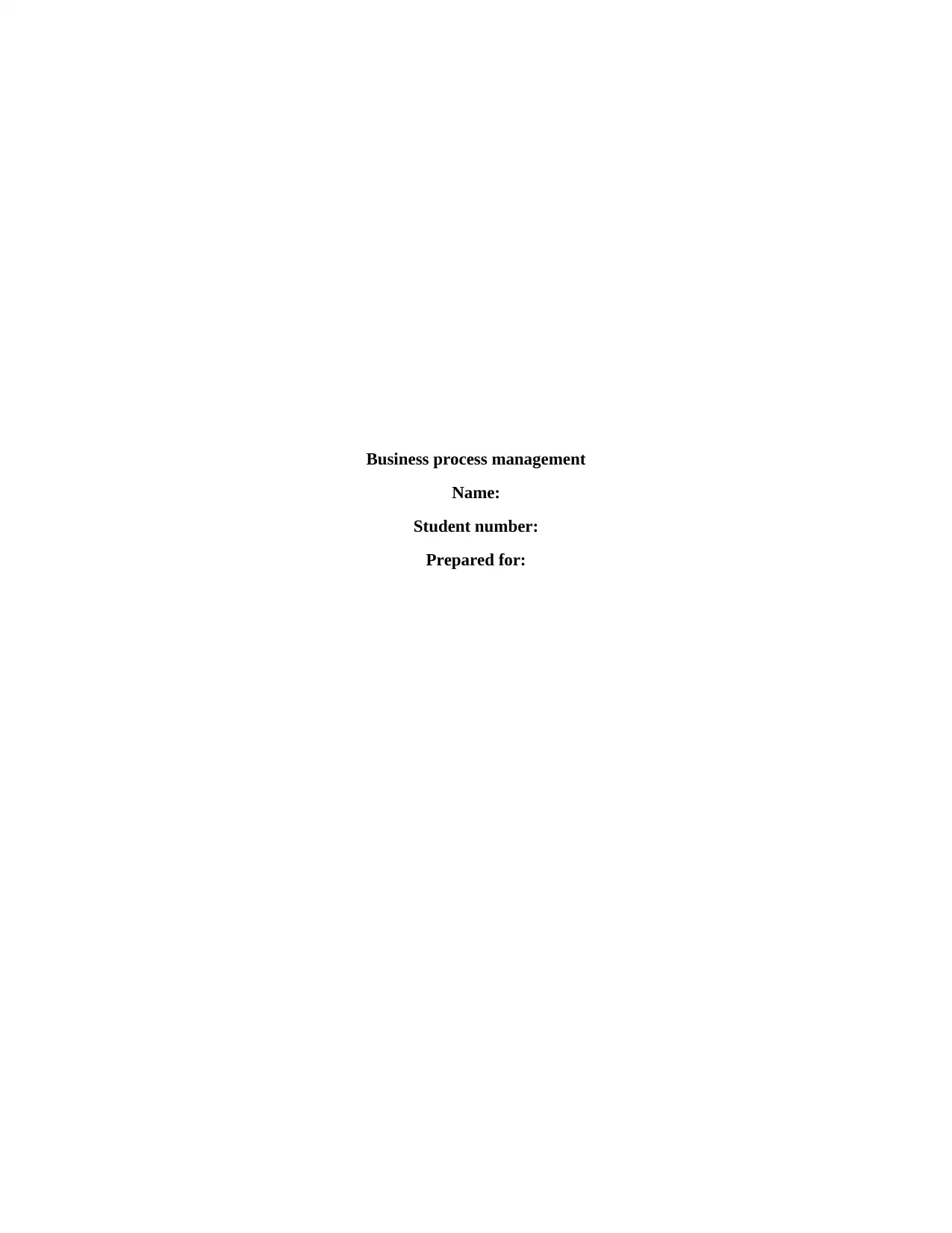
Business process management
Name:
Student number:
Prepared for:
Name:
Student number:
Prepared for:
Paraphrase This Document
Need a fresh take? Get an instant paraphrase of this document with our AI Paraphraser
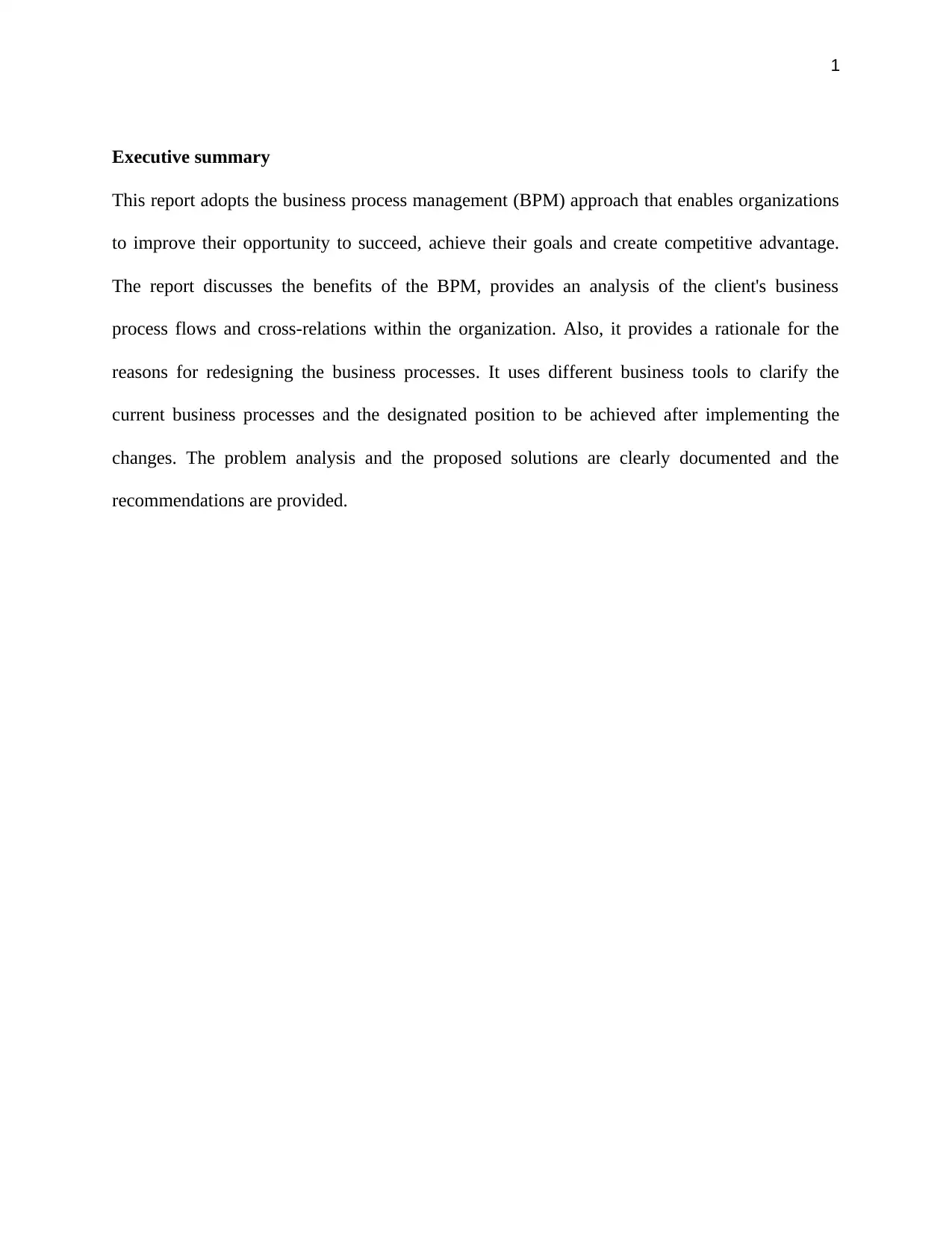
1
Executive summary
This report adopts the business process management (BPM) approach that enables organizations
to improve their opportunity to succeed, achieve their goals and create competitive advantage.
The report discusses the benefits of the BPM, provides an analysis of the client's business
process flows and cross-relations within the organization. Also, it provides a rationale for the
reasons for redesigning the business processes. It uses different business tools to clarify the
current business processes and the designated position to be achieved after implementing the
changes. The problem analysis and the proposed solutions are clearly documented and the
recommendations are provided.
Executive summary
This report adopts the business process management (BPM) approach that enables organizations
to improve their opportunity to succeed, achieve their goals and create competitive advantage.
The report discusses the benefits of the BPM, provides an analysis of the client's business
process flows and cross-relations within the organization. Also, it provides a rationale for the
reasons for redesigning the business processes. It uses different business tools to clarify the
current business processes and the designated position to be achieved after implementing the
changes. The problem analysis and the proposed solutions are clearly documented and the
recommendations are provided.
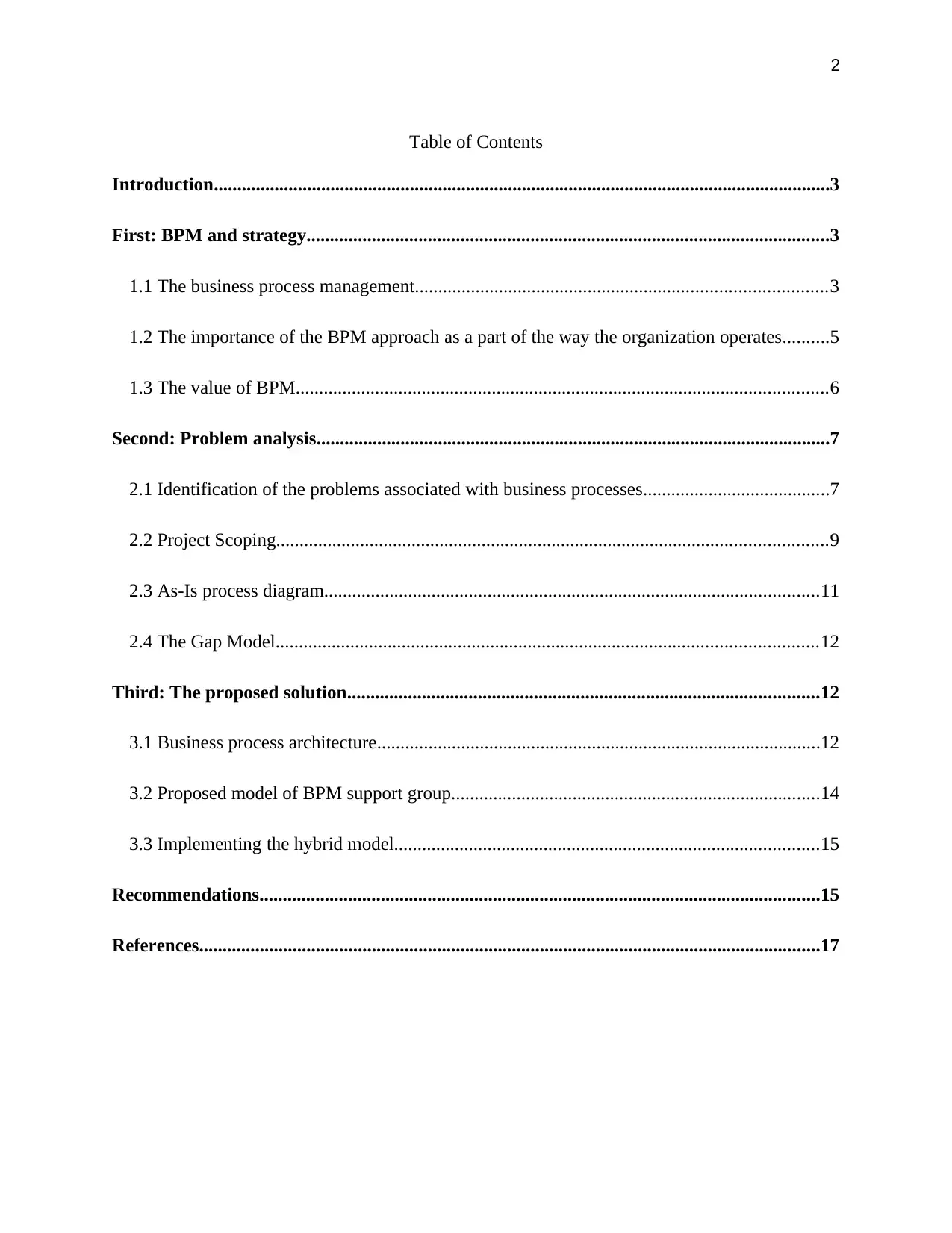
2
Table of Contents
Introduction....................................................................................................................................3
First: BPM and strategy................................................................................................................3
1.1 The business process management........................................................................................3
1.2 The importance of the BPM approach as a part of the way the organization operates..........5
1.3 The value of BPM..................................................................................................................6
Second: Problem analysis..............................................................................................................7
2.1 Identification of the problems associated with business processes........................................7
2.2 Project Scoping......................................................................................................................9
2.3 As-Is process diagram..........................................................................................................11
2.4 The Gap Model....................................................................................................................12
Third: The proposed solution.....................................................................................................12
3.1 Business process architecture...............................................................................................12
3.2 Proposed model of BPM support group...............................................................................14
3.3 Implementing the hybrid model...........................................................................................15
Recommendations........................................................................................................................15
References.....................................................................................................................................17
Table of Contents
Introduction....................................................................................................................................3
First: BPM and strategy................................................................................................................3
1.1 The business process management........................................................................................3
1.2 The importance of the BPM approach as a part of the way the organization operates..........5
1.3 The value of BPM..................................................................................................................6
Second: Problem analysis..............................................................................................................7
2.1 Identification of the problems associated with business processes........................................7
2.2 Project Scoping......................................................................................................................9
2.3 As-Is process diagram..........................................................................................................11
2.4 The Gap Model....................................................................................................................12
Third: The proposed solution.....................................................................................................12
3.1 Business process architecture...............................................................................................12
3.2 Proposed model of BPM support group...............................................................................14
3.3 Implementing the hybrid model...........................................................................................15
Recommendations........................................................................................................................15
References.....................................................................................................................................17
⊘ This is a preview!⊘
Do you want full access?
Subscribe today to unlock all pages.

Trusted by 1+ million students worldwide
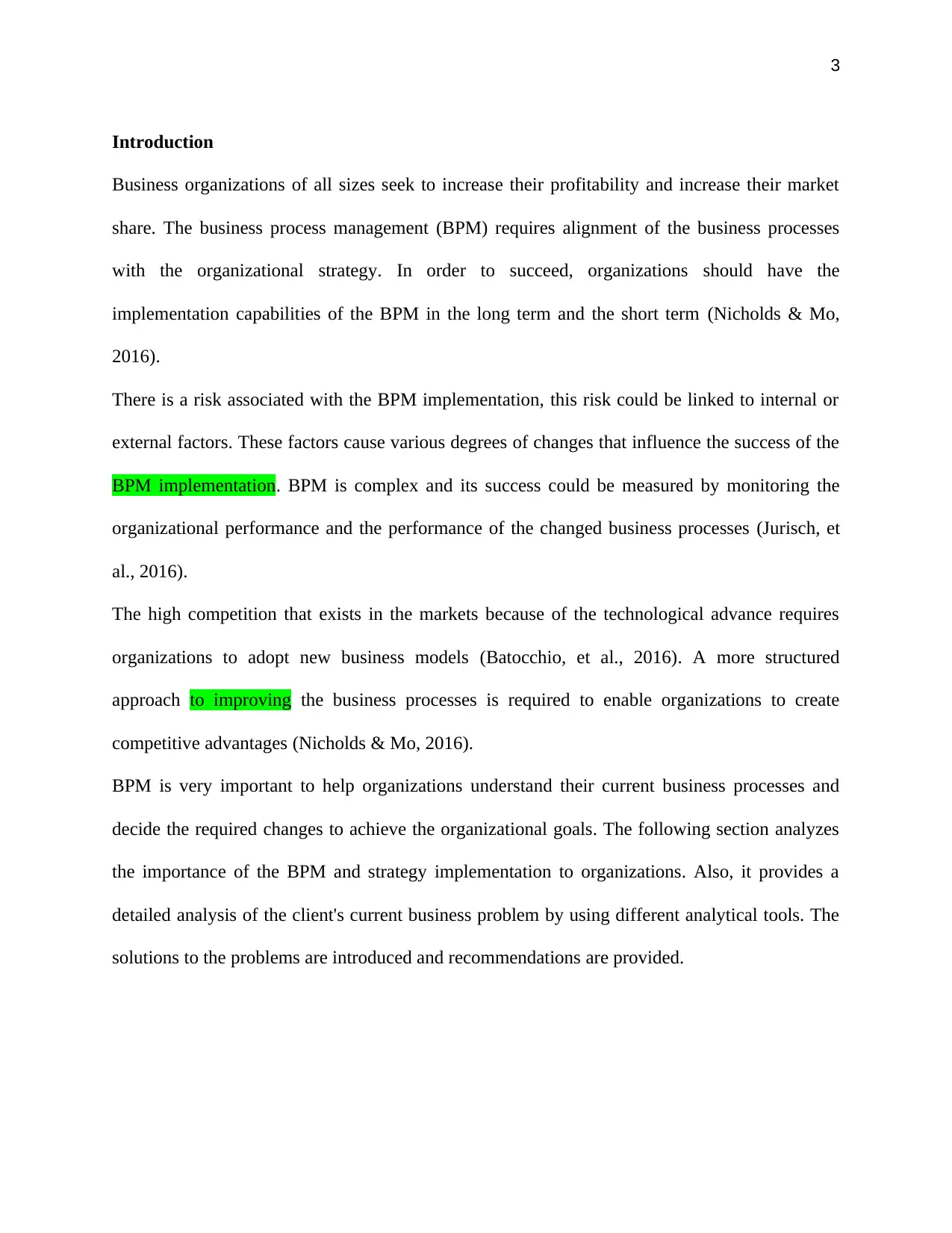
3
Introduction
Business organizations of all sizes seek to increase their profitability and increase their market
share. The business process management (BPM) requires alignment of the business processes
with the organizational strategy. In order to succeed, organizations should have the
implementation capabilities of the BPM in the long term and the short term (Nicholds & Mo,
2016).
There is a risk associated with the BPM implementation, this risk could be linked to internal or
external factors. These factors cause various degrees of changes that influence the success of the
BPM implementation. BPM is complex and its success could be measured by monitoring the
organizational performance and the performance of the changed business processes (Jurisch, et
al., 2016).
The high competition that exists in the markets because of the technological advance requires
organizations to adopt new business models (Batocchio, et al., 2016). A more structured
approach to improving the business processes is required to enable organizations to create
competitive advantages (Nicholds & Mo, 2016).
BPM is very important to help organizations understand their current business processes and
decide the required changes to achieve the organizational goals. The following section analyzes
the importance of the BPM and strategy implementation to organizations. Also, it provides a
detailed analysis of the client's current business problem by using different analytical tools. The
solutions to the problems are introduced and recommendations are provided.
Introduction
Business organizations of all sizes seek to increase their profitability and increase their market
share. The business process management (BPM) requires alignment of the business processes
with the organizational strategy. In order to succeed, organizations should have the
implementation capabilities of the BPM in the long term and the short term (Nicholds & Mo,
2016).
There is a risk associated with the BPM implementation, this risk could be linked to internal or
external factors. These factors cause various degrees of changes that influence the success of the
BPM implementation. BPM is complex and its success could be measured by monitoring the
organizational performance and the performance of the changed business processes (Jurisch, et
al., 2016).
The high competition that exists in the markets because of the technological advance requires
organizations to adopt new business models (Batocchio, et al., 2016). A more structured
approach to improving the business processes is required to enable organizations to create
competitive advantages (Nicholds & Mo, 2016).
BPM is very important to help organizations understand their current business processes and
decide the required changes to achieve the organizational goals. The following section analyzes
the importance of the BPM and strategy implementation to organizations. Also, it provides a
detailed analysis of the client's current business problem by using different analytical tools. The
solutions to the problems are introduced and recommendations are provided.
Paraphrase This Document
Need a fresh take? Get an instant paraphrase of this document with our AI Paraphraser
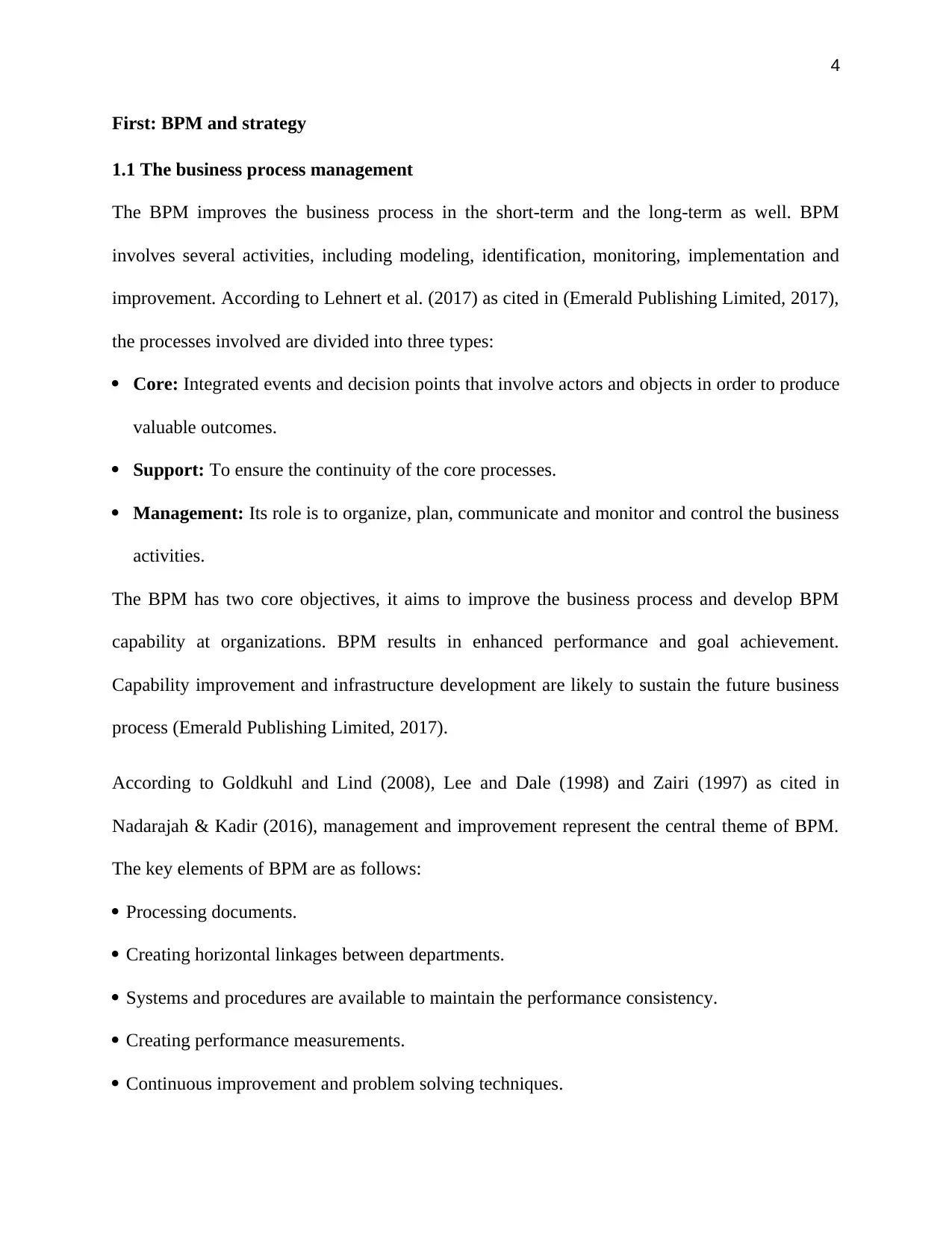
4
First: BPM and strategy
1.1 The business process management
The BPM improves the business process in the short-term and the long-term as well. BPM
involves several activities, including modeling, identification, monitoring, implementation and
improvement. According to Lehnert et al. (2017) as cited in (Emerald Publishing Limited, 2017),
the processes involved are divided into three types:
Core: Integrated events and decision points that involve actors and objects in order to produce
valuable outcomes.
Support: To ensure the continuity of the core processes.
Management: Its role is to organize, plan, communicate and monitor and control the business
activities.
The BPM has two core objectives, it aims to improve the business process and develop BPM
capability at organizations. BPM results in enhanced performance and goal achievement.
Capability improvement and infrastructure development are likely to sustain the future business
process (Emerald Publishing Limited, 2017).
According to Goldkuhl and Lind (2008), Lee and Dale (1998) and Zairi (1997) as cited in
Nadarajah & Kadir (2016), management and improvement represent the central theme of BPM.
The key elements of BPM are as follows:
Processing documents.
Creating horizontal linkages between departments.
Systems and procedures are available to maintain the performance consistency.
Creating performance measurements.
Continuous improvement and problem solving techniques.
First: BPM and strategy
1.1 The business process management
The BPM improves the business process in the short-term and the long-term as well. BPM
involves several activities, including modeling, identification, monitoring, implementation and
improvement. According to Lehnert et al. (2017) as cited in (Emerald Publishing Limited, 2017),
the processes involved are divided into three types:
Core: Integrated events and decision points that involve actors and objects in order to produce
valuable outcomes.
Support: To ensure the continuity of the core processes.
Management: Its role is to organize, plan, communicate and monitor and control the business
activities.
The BPM has two core objectives, it aims to improve the business process and develop BPM
capability at organizations. BPM results in enhanced performance and goal achievement.
Capability improvement and infrastructure development are likely to sustain the future business
process (Emerald Publishing Limited, 2017).
According to Goldkuhl and Lind (2008), Lee and Dale (1998) and Zairi (1997) as cited in
Nadarajah & Kadir (2016), management and improvement represent the central theme of BPM.
The key elements of BPM are as follows:
Processing documents.
Creating horizontal linkages between departments.
Systems and procedures are available to maintain the performance consistency.
Creating performance measurements.
Continuous improvement and problem solving techniques.
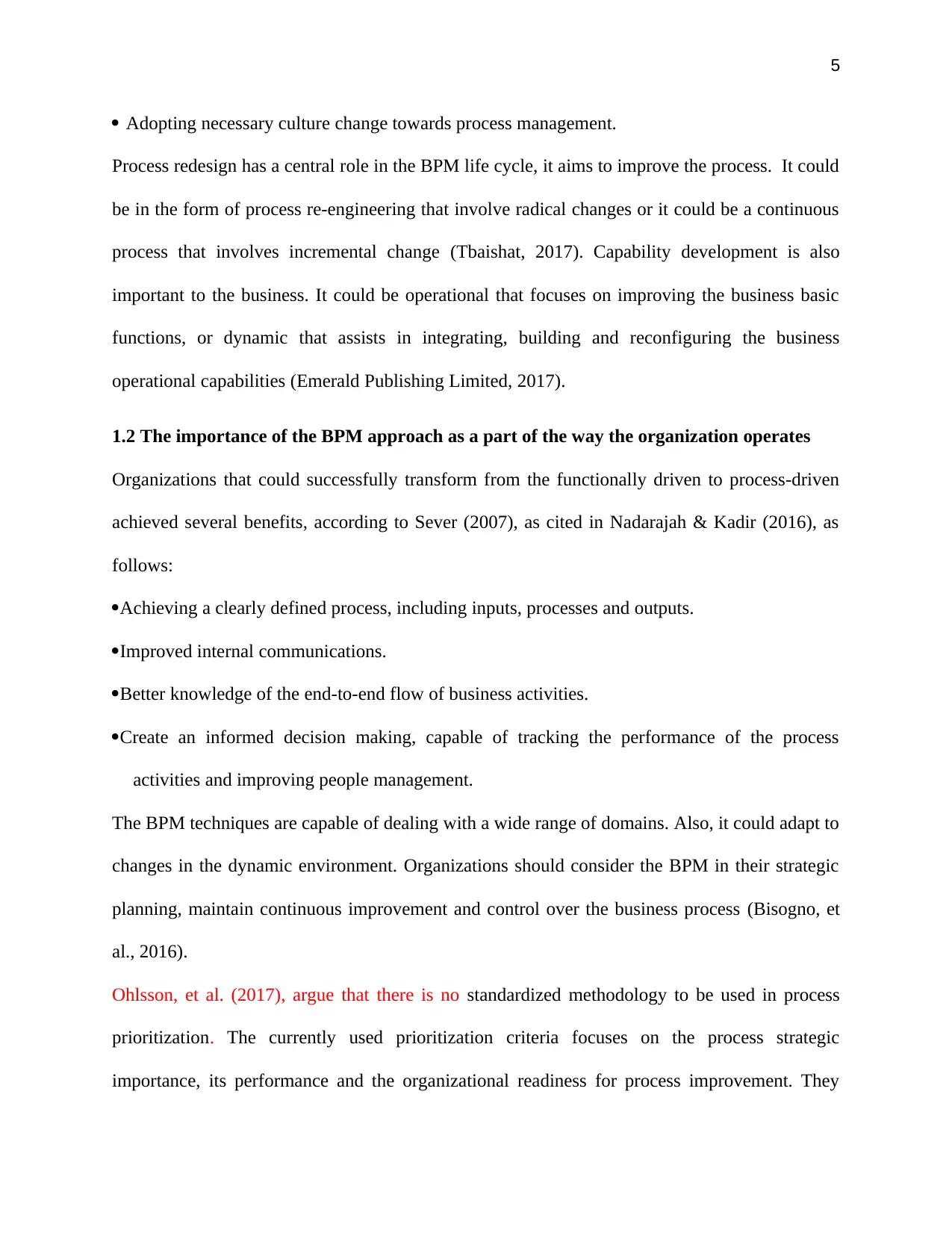
5
Adopting necessary culture change towards process management.
Process redesign has a central role in the BPM life cycle, it aims to improve the process. It could
be in the form of process re-engineering that involve radical changes or it could be a continuous
process that involves incremental change (Tbaishat, 2017). Capability development is also
important to the business. It could be operational that focuses on improving the business basic
functions, or dynamic that assists in integrating, building and reconfiguring the business
operational capabilities (Emerald Publishing Limited, 2017).
1.2 The importance of the BPM approach as a part of the way the organization operates
Organizations that could successfully transform from the functionally driven to process-driven
achieved several benefits, according to Sever (2007), as cited in Nadarajah & Kadir (2016), as
follows:
Achieving a clearly defined process, including inputs, processes and outputs.
Improved internal communications.
Better knowledge of the end-to-end flow of business activities.
Create an informed decision making, capable of tracking the performance of the process
activities and improving people management.
The BPM techniques are capable of dealing with a wide range of domains. Also, it could adapt to
changes in the dynamic environment. Organizations should consider the BPM in their strategic
planning, maintain continuous improvement and control over the business process (Bisogno, et
al., 2016).
Ohlsson, et al. (2017), argue that there is no standardized methodology to be used in process
prioritization. The currently used prioritization criteria focuses on the process strategic
importance, its performance and the organizational readiness for process improvement. They
Adopting necessary culture change towards process management.
Process redesign has a central role in the BPM life cycle, it aims to improve the process. It could
be in the form of process re-engineering that involve radical changes or it could be a continuous
process that involves incremental change (Tbaishat, 2017). Capability development is also
important to the business. It could be operational that focuses on improving the business basic
functions, or dynamic that assists in integrating, building and reconfiguring the business
operational capabilities (Emerald Publishing Limited, 2017).
1.2 The importance of the BPM approach as a part of the way the organization operates
Organizations that could successfully transform from the functionally driven to process-driven
achieved several benefits, according to Sever (2007), as cited in Nadarajah & Kadir (2016), as
follows:
Achieving a clearly defined process, including inputs, processes and outputs.
Improved internal communications.
Better knowledge of the end-to-end flow of business activities.
Create an informed decision making, capable of tracking the performance of the process
activities and improving people management.
The BPM techniques are capable of dealing with a wide range of domains. Also, it could adapt to
changes in the dynamic environment. Organizations should consider the BPM in their strategic
planning, maintain continuous improvement and control over the business process (Bisogno, et
al., 2016).
Ohlsson, et al. (2017), argue that there is no standardized methodology to be used in process
prioritization. The currently used prioritization criteria focuses on the process strategic
importance, its performance and the organizational readiness for process improvement. They
⊘ This is a preview!⊘
Do you want full access?
Subscribe today to unlock all pages.

Trusted by 1+ million students worldwide
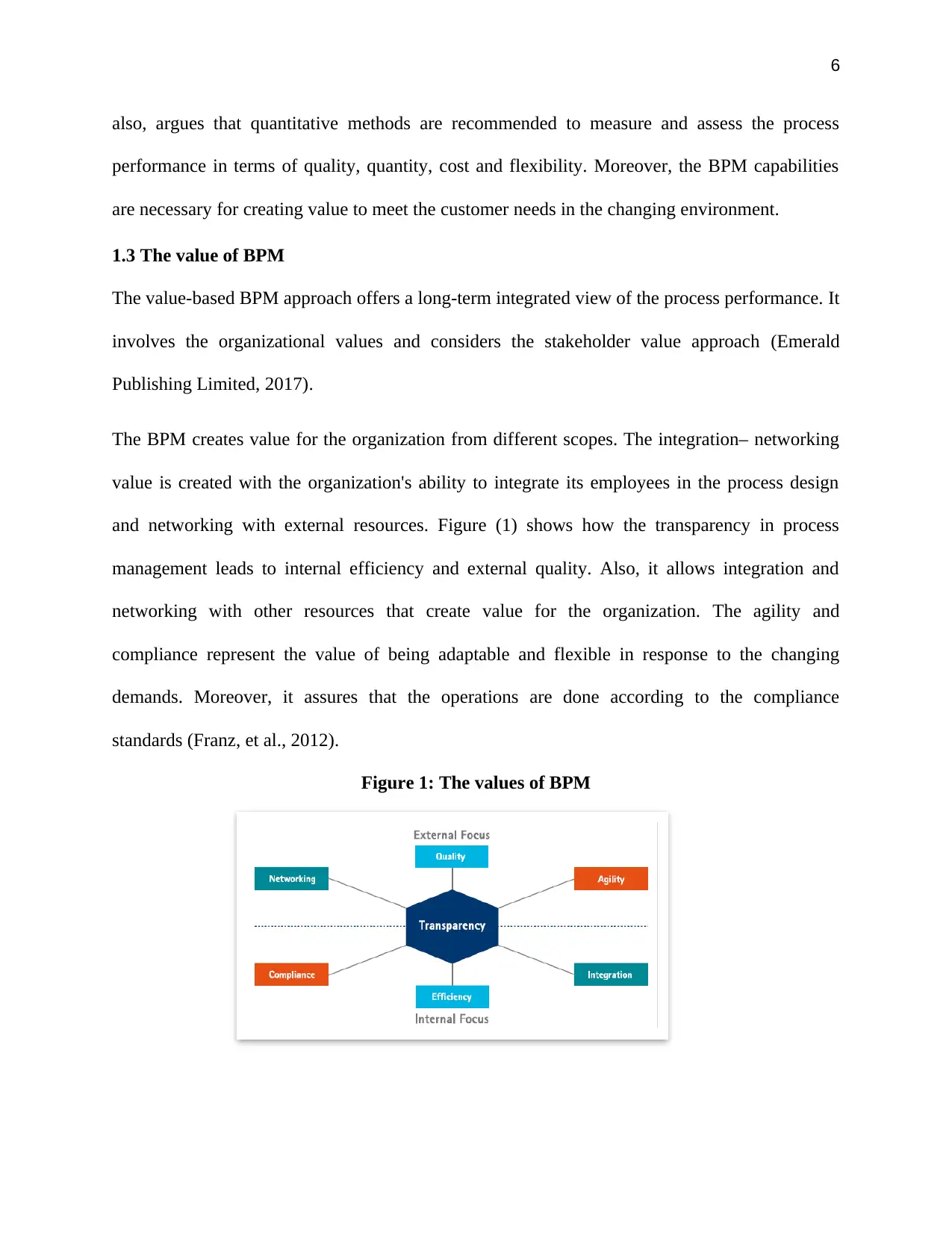
6
also, argues that quantitative methods are recommended to measure and assess the process
performance in terms of quality, quantity, cost and flexibility. Moreover, the BPM capabilities
are necessary for creating value to meet the customer needs in the changing environment.
1.3 The value of BPM
The value-based BPM approach offers a long-term integrated view of the process performance. It
involves the organizational values and considers the stakeholder value approach (Emerald
Publishing Limited, 2017).
The BPM creates value for the organization from different scopes. The integration– networking
value is created with the organization's ability to integrate its employees in the process design
and networking with external resources. Figure (1) shows how the transparency in process
management leads to internal efficiency and external quality. Also, it allows integration and
networking with other resources that create value for the organization. The agility and
compliance represent the value of being adaptable and flexible in response to the changing
demands. Moreover, it assures that the operations are done according to the compliance
standards (Franz, et al., 2012).
Figure 1: The values of BPM
also, argues that quantitative methods are recommended to measure and assess the process
performance in terms of quality, quantity, cost and flexibility. Moreover, the BPM capabilities
are necessary for creating value to meet the customer needs in the changing environment.
1.3 The value of BPM
The value-based BPM approach offers a long-term integrated view of the process performance. It
involves the organizational values and considers the stakeholder value approach (Emerald
Publishing Limited, 2017).
The BPM creates value for the organization from different scopes. The integration– networking
value is created with the organization's ability to integrate its employees in the process design
and networking with external resources. Figure (1) shows how the transparency in process
management leads to internal efficiency and external quality. Also, it allows integration and
networking with other resources that create value for the organization. The agility and
compliance represent the value of being adaptable and flexible in response to the changing
demands. Moreover, it assures that the operations are done according to the compliance
standards (Franz, et al., 2012).
Figure 1: The values of BPM
Paraphrase This Document
Need a fresh take? Get an instant paraphrase of this document with our AI Paraphraser
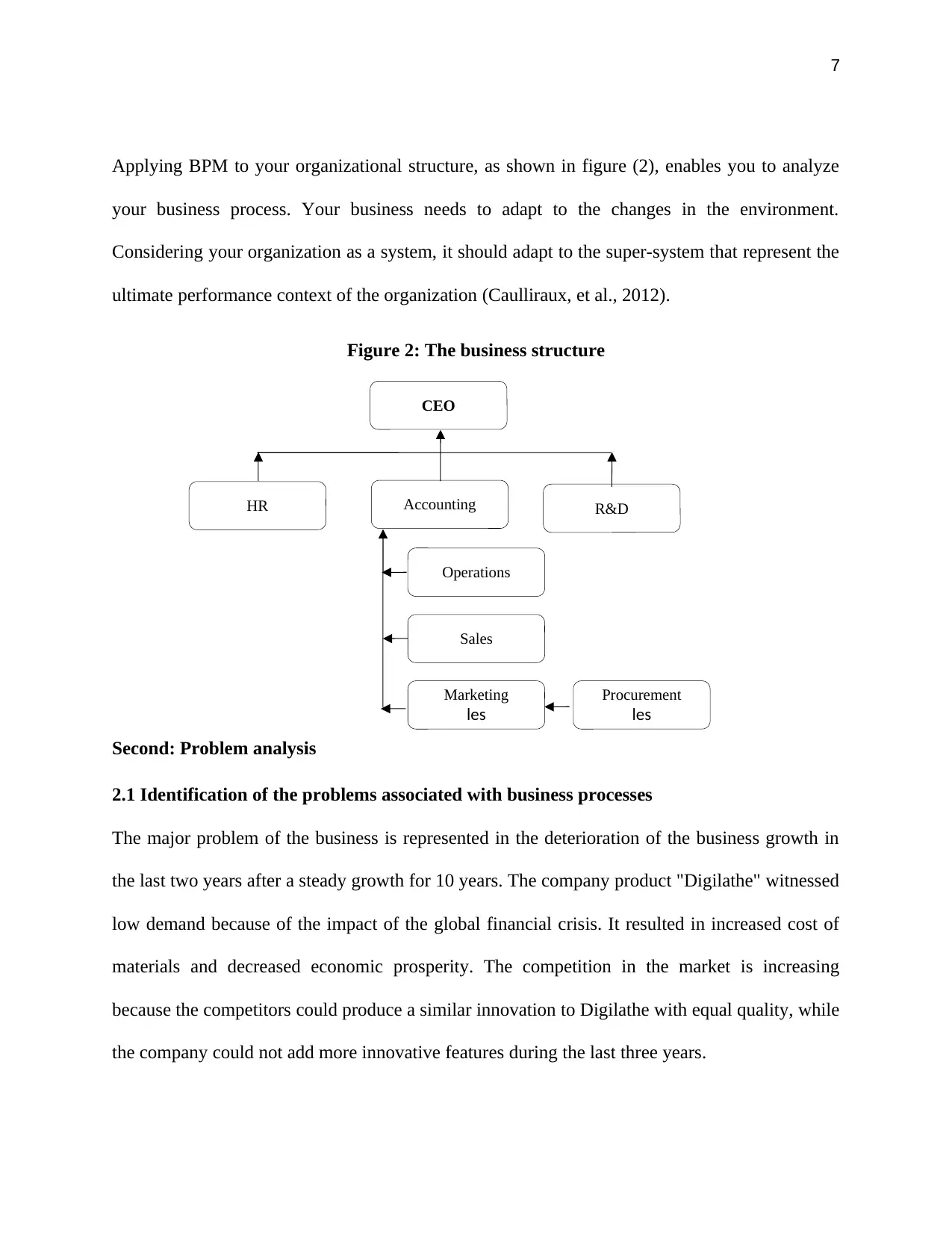
7
Applying BPM to your organizational structure, as shown in figure (2), enables you to analyze
your business process. Your business needs to adapt to the changes in the environment.
Considering your organization as a system, it should adapt to the super-system that represent the
ultimate performance context of the organization (Caulliraux, et al., 2012).
Figure 2: The business structure
Second: Problem analysis
2.1 Identification of the problems associated with business processes
The major problem of the business is represented in the deterioration of the business growth in
the last two years after a steady growth for 10 years. The company product "Digilathe" witnessed
low demand because of the impact of the global financial crisis. It resulted in increased cost of
materials and decreased economic prosperity. The competition in the market is increasing
because the competitors could produce a similar innovation to Digilathe with equal quality, while
the company could not add more innovative features during the last three years.
CEO
R&DAccounting
Operations
HR
Sales
Marketing
les
Procurement
les
Applying BPM to your organizational structure, as shown in figure (2), enables you to analyze
your business process. Your business needs to adapt to the changes in the environment.
Considering your organization as a system, it should adapt to the super-system that represent the
ultimate performance context of the organization (Caulliraux, et al., 2012).
Figure 2: The business structure
Second: Problem analysis
2.1 Identification of the problems associated with business processes
The major problem of the business is represented in the deterioration of the business growth in
the last two years after a steady growth for 10 years. The company product "Digilathe" witnessed
low demand because of the impact of the global financial crisis. It resulted in increased cost of
materials and decreased economic prosperity. The competition in the market is increasing
because the competitors could produce a similar innovation to Digilathe with equal quality, while
the company could not add more innovative features during the last three years.
CEO
R&DAccounting
Operations
HR
Sales
Marketing
les
Procurement
les
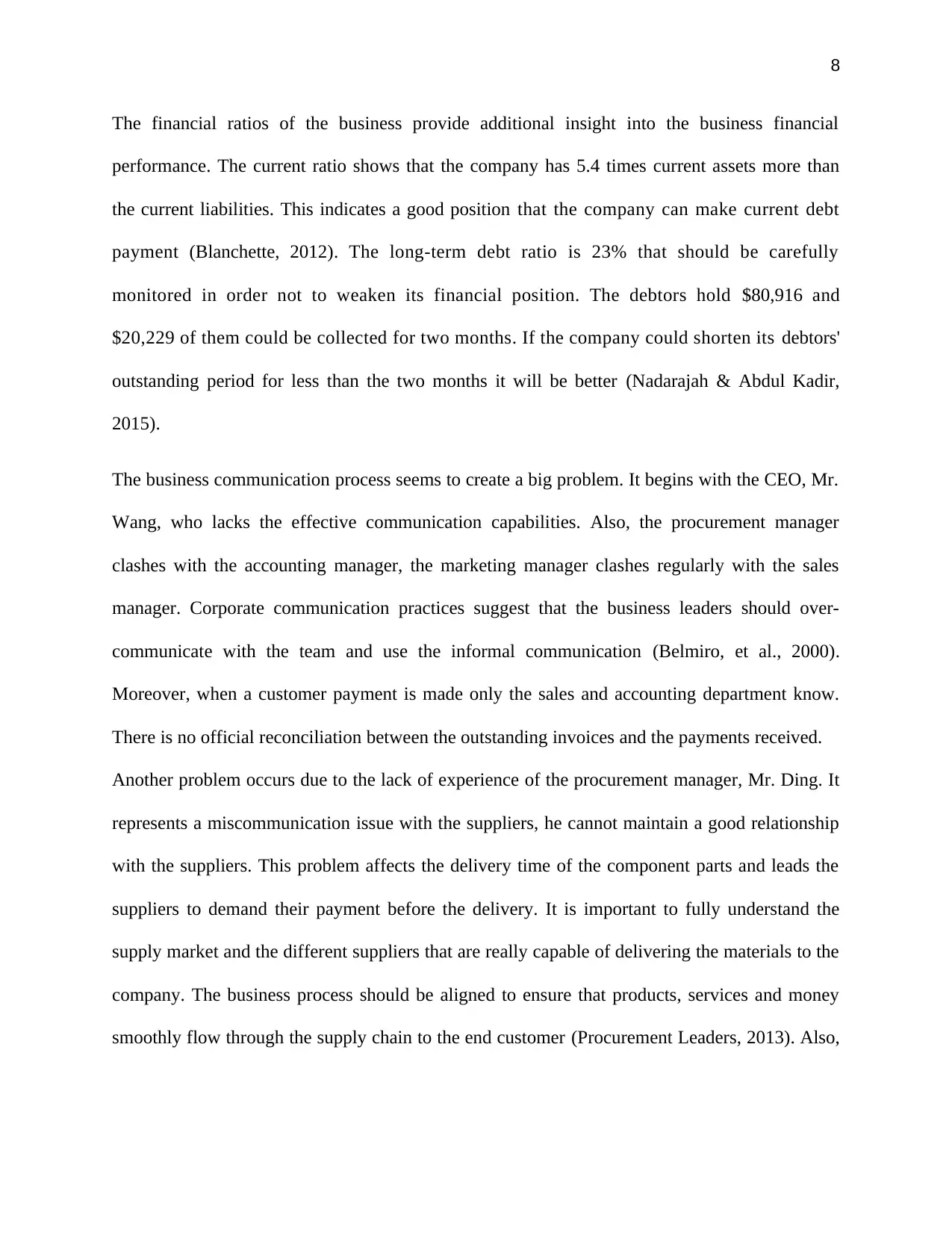
8
The financial ratios of the business provide additional insight into the business financial
performance. The current ratio shows that the company has 5.4 times current assets more than
the current liabilities. This indicates a good position that the company can make current debt
payment (Blanchette, 2012). The long-term debt ratio is 23% that should be carefully
monitored in order not to weaken its financial position. The debtors hold $80,916 and
$20,229 of them could be collected for two months. If the company could shorten its debtors'
outstanding period for less than the two months it will be better (Nadarajah & Abdul Kadir,
2015).
The business communication process seems to create a big problem. It begins with the CEO, Mr.
Wang, who lacks the effective communication capabilities. Also, the procurement manager
clashes with the accounting manager, the marketing manager clashes regularly with the sales
manager. Corporate communication practices suggest that the business leaders should over-
communicate with the team and use the informal communication (Belmiro, et al., 2000).
Moreover, when a customer payment is made only the sales and accounting department know.
There is no official reconciliation between the outstanding invoices and the payments received.
Another problem occurs due to the lack of experience of the procurement manager, Mr. Ding. It
represents a miscommunication issue with the suppliers, he cannot maintain a good relationship
with the suppliers. This problem affects the delivery time of the component parts and leads the
suppliers to demand their payment before the delivery. It is important to fully understand the
supply market and the different suppliers that are really capable of delivering the materials to the
company. The business process should be aligned to ensure that products, services and money
smoothly flow through the supply chain to the end customer (Procurement Leaders, 2013). Also,
The financial ratios of the business provide additional insight into the business financial
performance. The current ratio shows that the company has 5.4 times current assets more than
the current liabilities. This indicates a good position that the company can make current debt
payment (Blanchette, 2012). The long-term debt ratio is 23% that should be carefully
monitored in order not to weaken its financial position. The debtors hold $80,916 and
$20,229 of them could be collected for two months. If the company could shorten its debtors'
outstanding period for less than the two months it will be better (Nadarajah & Abdul Kadir,
2015).
The business communication process seems to create a big problem. It begins with the CEO, Mr.
Wang, who lacks the effective communication capabilities. Also, the procurement manager
clashes with the accounting manager, the marketing manager clashes regularly with the sales
manager. Corporate communication practices suggest that the business leaders should over-
communicate with the team and use the informal communication (Belmiro, et al., 2000).
Moreover, when a customer payment is made only the sales and accounting department know.
There is no official reconciliation between the outstanding invoices and the payments received.
Another problem occurs due to the lack of experience of the procurement manager, Mr. Ding. It
represents a miscommunication issue with the suppliers, he cannot maintain a good relationship
with the suppliers. This problem affects the delivery time of the component parts and leads the
suppliers to demand their payment before the delivery. It is important to fully understand the
supply market and the different suppliers that are really capable of delivering the materials to the
company. The business process should be aligned to ensure that products, services and money
smoothly flow through the supply chain to the end customer (Procurement Leaders, 2013). Also,
⊘ This is a preview!⊘
Do you want full access?
Subscribe today to unlock all pages.

Trusted by 1+ million students worldwide
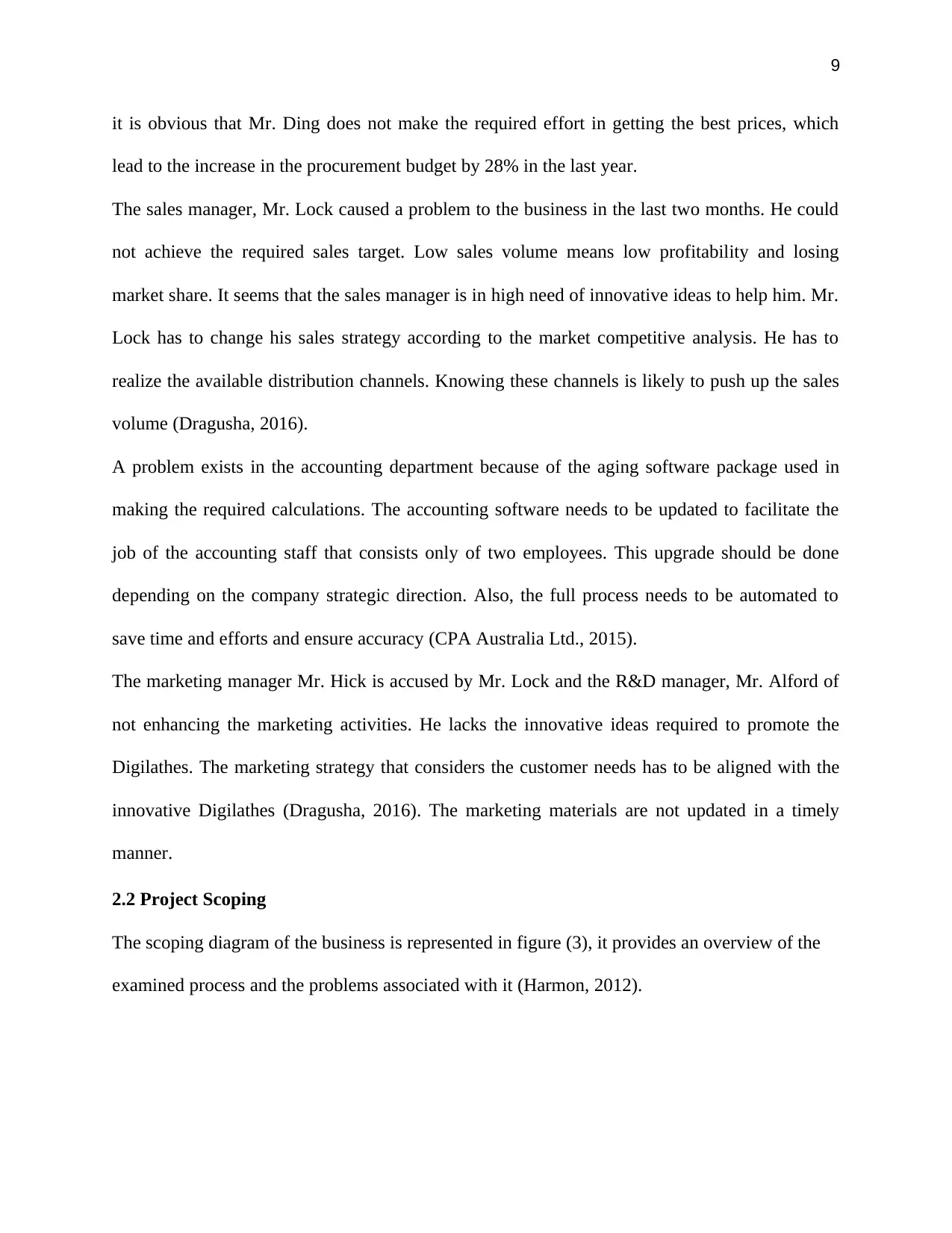
9
it is obvious that Mr. Ding does not make the required effort in getting the best prices, which
lead to the increase in the procurement budget by 28% in the last year.
The sales manager, Mr. Lock caused a problem to the business in the last two months. He could
not achieve the required sales target. Low sales volume means low profitability and losing
market share. It seems that the sales manager is in high need of innovative ideas to help him. Mr.
Lock has to change his sales strategy according to the market competitive analysis. He has to
realize the available distribution channels. Knowing these channels is likely to push up the sales
volume (Dragusha, 2016).
A problem exists in the accounting department because of the aging software package used in
making the required calculations. The accounting software needs to be updated to facilitate the
job of the accounting staff that consists only of two employees. This upgrade should be done
depending on the company strategic direction. Also, the full process needs to be automated to
save time and efforts and ensure accuracy (CPA Australia Ltd., 2015).
The marketing manager Mr. Hick is accused by Mr. Lock and the R&D manager, Mr. Alford of
not enhancing the marketing activities. He lacks the innovative ideas required to promote the
Digilathes. The marketing strategy that considers the customer needs has to be aligned with the
innovative Digilathes (Dragusha, 2016). The marketing materials are not updated in a timely
manner.
2.2 Project Scoping
The scoping diagram of the business is represented in figure (3), it provides an overview of the
examined process and the problems associated with it (Harmon, 2012).
it is obvious that Mr. Ding does not make the required effort in getting the best prices, which
lead to the increase in the procurement budget by 28% in the last year.
The sales manager, Mr. Lock caused a problem to the business in the last two months. He could
not achieve the required sales target. Low sales volume means low profitability and losing
market share. It seems that the sales manager is in high need of innovative ideas to help him. Mr.
Lock has to change his sales strategy according to the market competitive analysis. He has to
realize the available distribution channels. Knowing these channels is likely to push up the sales
volume (Dragusha, 2016).
A problem exists in the accounting department because of the aging software package used in
making the required calculations. The accounting software needs to be updated to facilitate the
job of the accounting staff that consists only of two employees. This upgrade should be done
depending on the company strategic direction. Also, the full process needs to be automated to
save time and efforts and ensure accuracy (CPA Australia Ltd., 2015).
The marketing manager Mr. Hick is accused by Mr. Lock and the R&D manager, Mr. Alford of
not enhancing the marketing activities. He lacks the innovative ideas required to promote the
Digilathes. The marketing strategy that considers the customer needs has to be aligned with the
innovative Digilathes (Dragusha, 2016). The marketing materials are not updated in a timely
manner.
2.2 Project Scoping
The scoping diagram of the business is represented in figure (3), it provides an overview of the
examined process and the problems associated with it (Harmon, 2012).
Paraphrase This Document
Need a fresh take? Get an instant paraphrase of this document with our AI Paraphraser
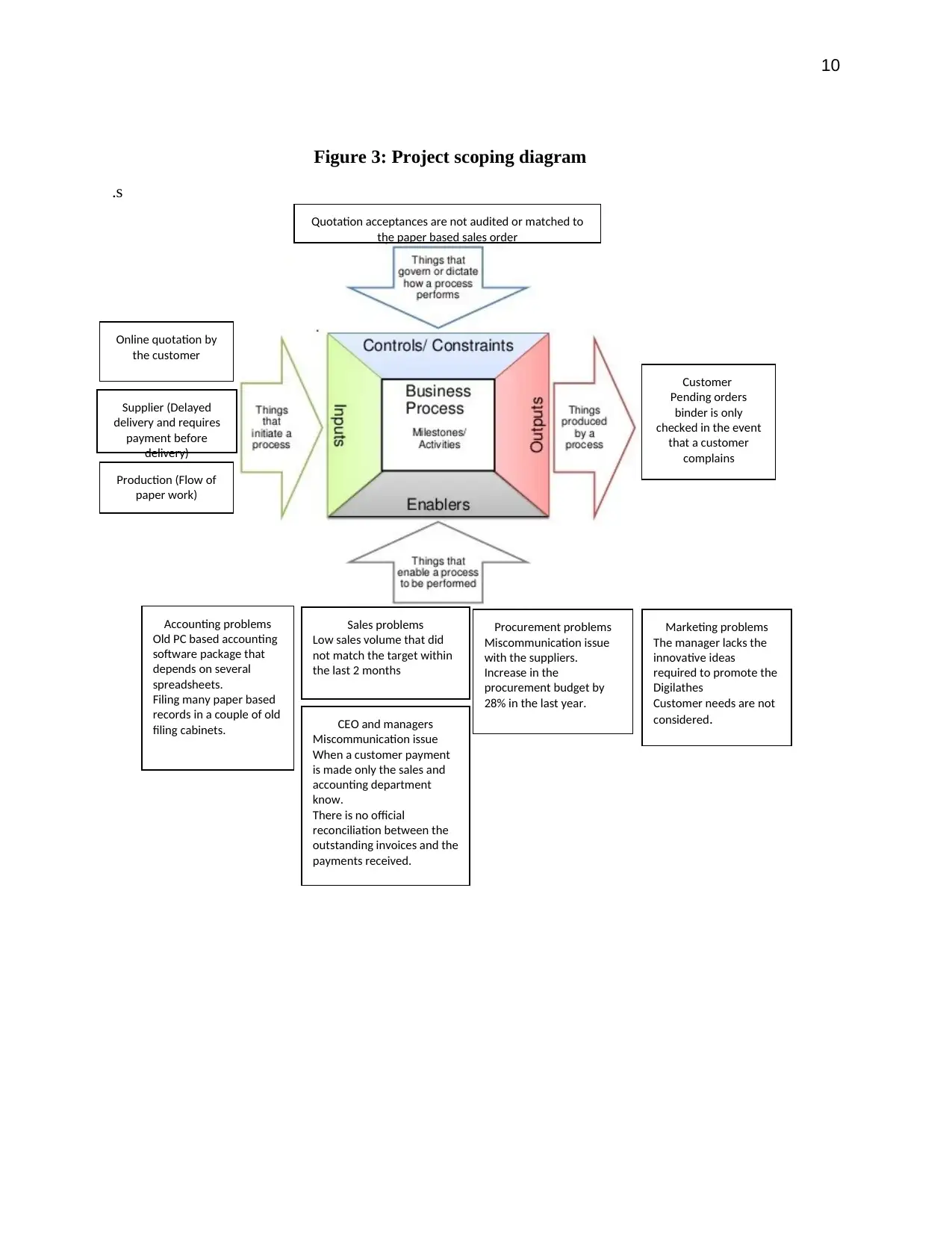
10
Figure 3: Project scoping diagram
s.
Online quotation by
the customer
Supplier (Delayed
delivery and requires
payment before
delivery)
Production (Flow of
paper work)
Quotation acceptances are not audited or matched to
the paper based sales order
Accounting problems
Old PC based accounting
software package that
depends on several
spreadsheets.
Filing many paper based
records in a couple of old
filing cabinets.
Sales problems
Low sales volume that did
not match the target within
the last 2 months
CEO and managers
Miscommunication issue
When a customer payment
is made only the sales and
accounting department
know.
There is no official
reconciliation between the
outstanding invoices and the
payments received.
Marketing problems
The manager lacks the
innovative ideas
required to promote the
Digilathes
Customer needs are not
considered.
Procurement problems
Miscommunication issue
with the suppliers.
Increase in the
procurement budget by
28% in the last year.
Customer
Pending orders
binder is only
checked in the event
that a customer
complains
Figure 3: Project scoping diagram
s.
Online quotation by
the customer
Supplier (Delayed
delivery and requires
payment before
delivery)
Production (Flow of
paper work)
Quotation acceptances are not audited or matched to
the paper based sales order
Accounting problems
Old PC based accounting
software package that
depends on several
spreadsheets.
Filing many paper based
records in a couple of old
filing cabinets.
Sales problems
Low sales volume that did
not match the target within
the last 2 months
CEO and managers
Miscommunication issue
When a customer payment
is made only the sales and
accounting department
know.
There is no official
reconciliation between the
outstanding invoices and the
payments received.
Marketing problems
The manager lacks the
innovative ideas
required to promote the
Digilathes
Customer needs are not
considered.
Procurement problems
Miscommunication issue
with the suppliers.
Increase in the
procurement budget by
28% in the last year.
Customer
Pending orders
binder is only
checked in the event
that a customer
complains
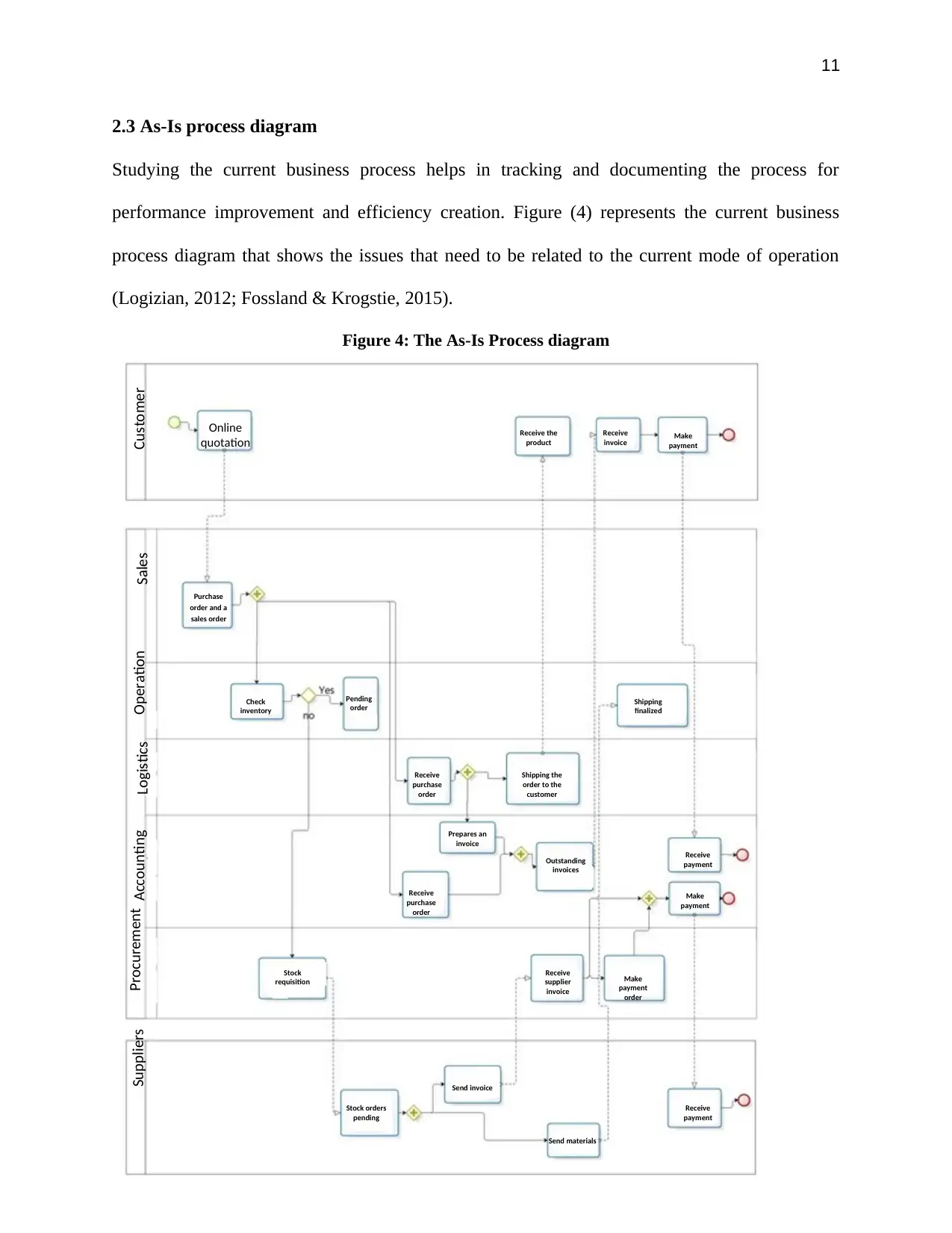
11
2.3 As-Is process diagram
Studying the current business process helps in tracking and documenting the process for
performance improvement and efficiency creation. Figure (4) represents the current business
process diagram that shows the issues that need to be related to the current mode of operation
(Logizian, 2012; Fossland & Krogstie, 2015).
Figure 4: The As-Is Process diagram
Sales
Purchase
order and a
sales order
Operation
Check
inventory
Pending
order
Receive
purchase
order
LogisticsAccountingProcurement Receive
purchase
order
Prepares an
invoice
Outstanding
invoices
Shipping the
order to the
customer
Shipping
finalized
Receive the
product
Receive
invoice Make
payment
Stock
requisition
Receive
payment
Make
payment
Stock orders
pending
Send invoice
Send materials
Receive
supplier
invoice
Make
payment
order
Receive
payment
Suppliers Customer
Online
quotation
2.3 As-Is process diagram
Studying the current business process helps in tracking and documenting the process for
performance improvement and efficiency creation. Figure (4) represents the current business
process diagram that shows the issues that need to be related to the current mode of operation
(Logizian, 2012; Fossland & Krogstie, 2015).
Figure 4: The As-Is Process diagram
Sales
Purchase
order and a
sales order
Operation
Check
inventory
Pending
order
Receive
purchase
order
LogisticsAccountingProcurement Receive
purchase
order
Prepares an
invoice
Outstanding
invoices
Shipping the
order to the
customer
Shipping
finalized
Receive the
product
Receive
invoice Make
payment
Stock
requisition
Receive
payment
Make
payment
Stock orders
pending
Send invoice
Send materials
Receive
supplier
invoice
Make
payment
order
Receive
payment
Suppliers Customer
Online
quotation
⊘ This is a preview!⊘
Do you want full access?
Subscribe today to unlock all pages.

Trusted by 1+ million students worldwide
1 out of 20
Related Documents
Your All-in-One AI-Powered Toolkit for Academic Success.
+13062052269
info@desklib.com
Available 24*7 on WhatsApp / Email
![[object Object]](/_next/static/media/star-bottom.7253800d.svg)
Unlock your academic potential
Copyright © 2020–2025 A2Z Services. All Rights Reserved. Developed and managed by ZUCOL.





